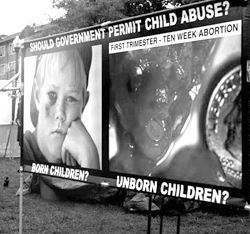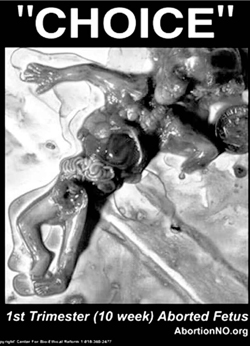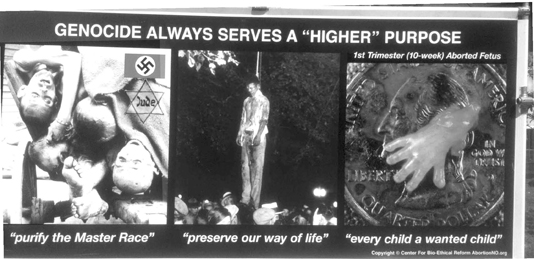Case against abortion is painful to watch
By Lenny Palumbo
 |
 |
(Publishers: the views expressed here are those of the author are the illustrations. If you are squeamish or do not like freedom of speech or expression, please do not read the story or look at the pictures.)
Two weeks ago, a young woman named Tonya Reaves died after a botched abortion took place at a Planned Parenthood clinic in Chicago. An autopsy revealed her cause of death to be “hemorrhage, with a cervical dilation and evacuation, as well as an intrauterine pregnancy as contributing causes.” Reaves also suffered a perforated uterus.
Recently released documents show Planned Parenthood waited over five hours before calling an ambulance. When Reaves finally arrived at Northwestern Memorial Hospital she was pronounced dead.
The incident rekindled the fiery debate between pro-life and pro-abortion supporters over what some call the American Holocaust.
According to the Guttmacher Institute, nearly 50 million legal abortions have taken place in the U.S. between 1973 and 2008. Worldwide, approximately 42 million abortions are performed every year.
For many pro-life supporters these statistics make abortion the most horrific atrocity of all time.
A 30-minute film released last fall called “180” stoked the flames of the abortion controversy by comparing the procedure to the “Holocaust” of World War II attributed to Adolph Hitler and the Nazis. Graphic imagery is used to compare WWII atrocities to abortion.
The film, produced, directed and written by Christian minister Ray Comfort, has been viewed on You Tube 3,270,651 as of August 6 2012.
It is aimed at young people and designed to alter the prevalent pro-choice position many of them hold.

Abraham Foxman, national director of the Anti-defamation League, criticized “180” for making "a moral equivalency between the Holocaust and abortion." Foxman called the film “a perverse attempt to make a case against abortion in America through the cynical abuse of the memory of those killed in the Holocaust," and decried the use of concentration camp film footage.
The movie has, however, made a positive impression on some unlikely individuals. Mark Hall, lead singer of the band Casting Crows is one such person. “This short documentary has totally rocked my world this week,” said Hall. “Please check it out…I dare you to watch 180.”
The use of abortion imagery by pro-life activists has made the pro-abortion side nervous because of the powerful impact it has on viewers. In the same way that disturbing images of Nazi concentration camps has influenced the opinions of millions of people, abortion imagery also has a similar effect on those exposed to it.
At the forefront of the movement using graphic abortion imagery is the Genocide Awareness Project. The GAP is a traveling photo/mural exhibit that compares the contemporary genocide of abortion to historically recognized forms of genocide. It travels around the country visiting university campuses to show students what abortion actually does to unborn children. The goal is to get young people thinking about abortion in a broader historical context.
“By placing abortion images alongside traditionally recognized forms of genocide we are expanding the context in which people think about abortion,” reads a statement on its website. “Genocide is always built on the ‘choice’ of those in power to systematically destroy those who are not in power.”
The GAP uses displays produced by the Center for Bio-ethical Reform, a privately funded pro-life organization.
Director of Virginia Programs for the Center for Bio-Ethical Reform Nicole W. Cooley said the Genocide Awareness Project admits that comparisons of abortion to genocide are not exactly the same.
“There’s points of comparison; we’re not saying they’re identical,” Cooley said.
Her organization argues that a denial of personhood attempting to serve a higher purpose through abortion and the use of dehumanizing language bear a resemblance to historical genocides like the Holocaust and Rwandan Genocide.
“In genocide you see dehumanizing language to describe the victimized class … when we have a wanted preborn child … we call it a baby, if it’s not wanted, now you have a fetus, a product of conception, a glob of tissue (or) a clump of cells,” Cooley said.
Although the GAP uses genocide to stress its position, Cooley says the ultimate message boils down to one simple fact: “…In all cases it’s wrong to kill another human being for an arbitrary reason.”
Many pro-choice women may not realize it but there are no arbitrary reasons for the feminist movement’s desire to legalize abortion. For years, the feminist movement in America pushed relentlessly for abortion rights because it believed abortion to be the ultimate empowerment of women over men. The legalization of abortion with Roe v Wade is often cited as a monumental breakthrough of overcoming male dominance.
Dr. Albert Mohler, however, challenges this dogma of feminism by arguing that abortion does not liberate women so much as it does empower men to take advantage of women:
“Prior to the legalization of abortion in the United States, it was commonly understood that a man should offer a woman marriage in case of pregnancy, and many did so. Though with the legalization of abortion, men started to feel that they were not responsible for the birth of children and consequently not under any obligation to marry. In gaining the option of abortion, many women have lost the option of marriage…
“Elective abortion changes everything. A woman’s choice for or against abortion breaks the causal link between conception and birth. It matters little what or who caused conception or whether the male insisted on having unprotected intercourse. It is she alone who finally decides whether the child comes into the world. She is the responsible one. For the first time in history, the father and the doctor and the health-insurance actuary can point a finger at her as the person who allowed an inconvenient human being to come into the world.”
It is the rare man who will fight for the right of the child he helped to create to enter this world. Most men who impregnate women unintentionally are happy to see their concubine take the easy way out by terminating pregnancy. With this inconvenient life out of the way, both can resume their self-centered lives uninterrupted. But what of the little one who has no say in the matter? What of the bloody, dismembered baby torn from his mother’s womb in the ultimate act of “empowerment” and selfishness? Take a good look at the images you see and ask yourself if the right to kill is more important than the right to live.